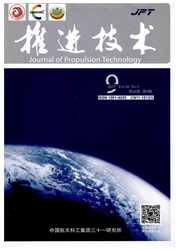

 中文摘要:
中文摘要:
为了研究液体火箭发动机中撞击式喷嘴的雾化问题,采用CLSVOF(Coupled Level-Set and Volume-of-Fluid Method )方法对撞击式喷嘴的雾化过程进行了数值仿真模拟,重点考察了撞击角对撞击式喷嘴雾化特性的影响。结果表明,通过CLSVOF方法能对射流撞击雾化形态进行较好的捕捉;分析整个雾化区域的液相分布,将射流撞击雾化过程中的液相分布大致分为三个区域:撞击前两股独立射流区域、撞击后形成的液膜区域、液膜破碎后液丝和液滴的生成区域;射流撞击雾化除了气液界面上速度差引起的不稳定之外,还存在由射流湍流或撞击波引起的其它不稳定因素;液膜破碎长度随撞击角的增大而减小,液膜表面上的表面波幅值及液膜破碎程度则随撞击角的增大而增大;射流撞击在撞击点位置处所形成的速度差对液膜的破碎和液膜上表面波幅值的大小起到了关键作用。
 英文摘要:
英文摘要:
Aiming at elucidating the detailed atomization process of the impinging-jet injector in liquid rock?et motor and the relationship between impingement angle and atomization characteristics of liquid sheet formed by the injector,numerical investigation of atomization characteristics of impinging jets injector is conducted based on the CLSVOF(Coupled Level-Set and Volume-of-Fluid Method)method. The study is focused on the effects of impingement angle on the atomization characteristics,and the simulation results are compared with the theoretic results. The simulation results show that the atomization characteristics of the liquid sheet formed by the impinging jets can be effectively captured by the CLSVOF method. By studying the liquid distribution of the atom?ization region,the liquid distribution in the atomization process can be divided into three regions:the separated jets region before the jets impact,the liquid sheet region after the jets impact and the formation of ligaments and droplets region. The present numerical results also show that the atomization process is affected not only by the in?stability caused by velocity difference on the gas-liquid interface,but also other factors such as turbulence inten?sity and impact wave. The breakup length of liquid sheet decreases with the increasing impingement angle ,the amplitude of surface wave on the liquid sheet and the breakup intensity of liquid sheet increase with the increas?ing impingement angle. The velocity difference at the location of impact point formed by the impinging jets plays a key role in the breakup of liquid sheet and formation of surface wave.
 同期刊论文项目
同期刊论文项目
 同项目期刊论文
同项目期刊论文
 Effects of NTO Oxidizer Temperature and Pressure on Hypergolic Ignition Delay and Life Time of Organ
Effects of NTO Oxidizer Temperature and Pressure on Hypergolic Ignition Delay and Life Time of Organ A Modified Implicit Iterative Difference Algorithm for Stiff Chemical Kinetic Equations in Complex C
A Modified Implicit Iterative Difference Algorithm for Stiff Chemical Kinetic Equations in Complex C Numerical simulation on a nanosecond-pulse surface dielectric barrier discharge actuator in near spa
Numerical simulation on a nanosecond-pulse surface dielectric barrier discharge actuator in near spa 期刊信息
期刊信息
